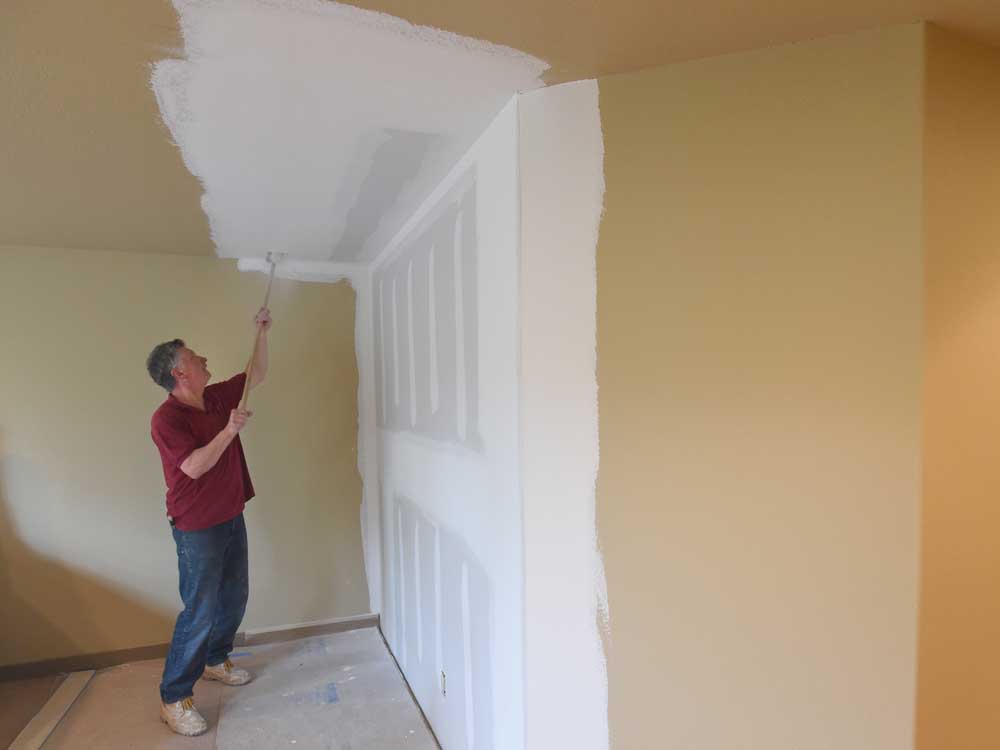Insurance companies: Bend’s snow damage “catastrophic”
Published 5:34 am Tuesday, March 28, 2017

- Kevin Borst, of Deschutes Drywall, works on repairing a section of wall in Bill Bernardy's home that was damaged from water soaking through the roof from an ice dam this year. Bernardy had five areas around his home damaged by water this winter. (Ryan Brennecke/Bulletin photo)
Bill Bernardy knew something was wrong with his home in northwest Bend when his wife sat down at her computer, and water started dripping from the ceiling onto her head.
Record-breaking winter storms had left inches of ice and snow piling up on the Bernardys’ roof. As it melted, water started to seep through the walls and ceiling — eventually soaking nearly every room in the home.
“(The wall) was so wet when you touched it, it felt like touching a sponge,” Bernardy said.
It will cost more than $25,000 to fix the damage, Bernardy said. While his scenario is extreme, he is not unlike hundreds of other homeowners who faced problems in the aftermath of this winter’s heavy snowfall. Damage to homes was so extensive citywide that city officials are considering changing codes to require more waterproof materials on roofs in Bend.
It’s unclear exactly how many homes have been damaged, but local insurance agents say they’ve never seen more claims filed in such a short period of time. Some national companies have gone as far as declaring Central Oregon an area with “catastrophic damage” — a title that’s usually is reserved for events like flooding, hurricanes and fires.
“I described it as an invisible disaster,” said Bernardy. “It’s happening behind people’s front doors.”
December 2016 and January 2017 each saw about 30 inches of snow, and accumulation reached record levels. Although the snow has melted, furniture and carpets in Bernardy’s home are still covered with plastic. Dozens of canned food items are piled up in a spare room after the pantry was soaked with water. Picture frames and artwork are stripped from the walls.
“Suddenly, it doesn’t seem much like a home,” Bernardy said.
Construction crews and insurance adjusters have been in and out of the home for months, Bernardy said. After local crews were so backed up, a crew from California came to rip out the drywall and set up fans and dehumidifiers. After that, another local contractor came to rebuild the walls, and now Bernardy is just waiting on crews to paint and re-carpet the home, he said.
Bernardy’s neighborhood was built within the last two decades, but he knows of at least 10 homes in his neighborhood that have been damaged. Local insurance adjusters say more people claimed damages in the past couple of months than at any time before — even for homes that were just months old.
“The phone was ringing nonstop,” said Patsy Melville, who owns of High Desert Insurance in Bend.
Melville said her company has been in business for about 15 years, and this is the worst event she’s seen. In some cases, the damage has been so bad that insurance companies are paying to put up clients in hotels and vacation rentals while their homes are fixed, she said.
“We had some people that had minimal damage,” said Melville. “But then we’ve had other people that all of a sudden they walked into their living rooms and their pictures started falling off the wall because the drywall was peeling off.”
Patrick O’Keefe, who owns Cascade Insurance Center in Bend, said that some insurance companies classified the damage as “catastrophic,” which usually happens in the aftermath of fires or hurricanes. Some insurance companies are sending staff to Bend from out of state to deal with people’s claims, O’Keefe said.
“I was here in 1992 and 1993 and we don’t remember this kind of damage, and we obviously had snow,” said O’Keefe, referencing the winter of 1992-93, which had particularly heavy snowfall.
The city of Bend has taken notice. The city’s building officials are discussing whether to change building codes to prevent damage from happening in severe storms in the future.
Right now, building codes in Bend require roofs to support a load of about 25 pounds per square foot, while codes in snowier towns require even stronger roofs — 35 pounds per square foot in Sisters, and 50 pounds per square foot in Sunriver.
Billy Staten, who works in Bend’s building safety division, said with the exception of the old Ray’s Food Place on Century Drive collapsing, the city hasn’t received any reports of buildings constructed with modern city codes that failed. Other roofs that collapsed, including that of the gym at Highland Magnet at Kenwood School, were built before current codes were adopted. City officials are investigating what happened at Ray’s, but increasing roof snow loads may not be necessary, he said.
Staten said the state is also in the process of reviewing Bend’s roof snow load requirements, and could decide to change the rules if it wants.
But the city is looking at other changes besides increasing roof loads. Staten said the city will probably start requiring an ice barrier, which adds an extra layer of protection beneath the shingles. The new rule would ensure that roofs have a second waterproof layer, which could prevent homes from being damaged by ice and snow building up on roofs.
Before that happens, city officials will work with the community to figure out a time line for changing the ice barrier rules, which can be implemented without the approval of the Bend City Council.
— Reporter: 541-633-2160, mriker@bendbulletin.com






